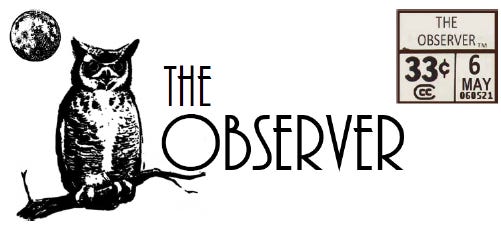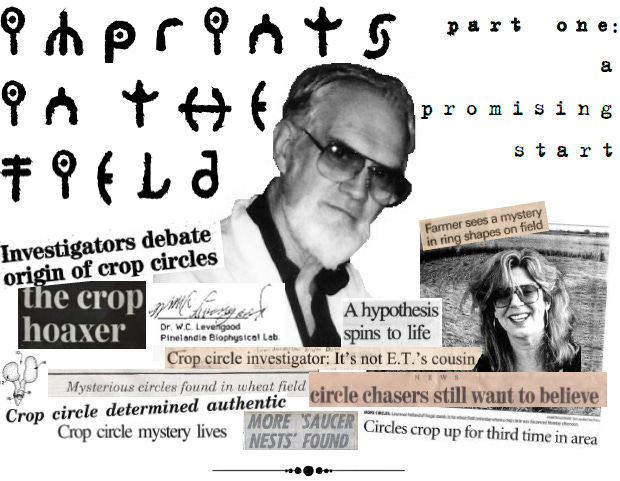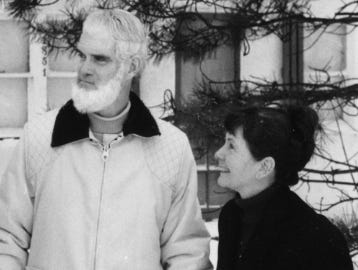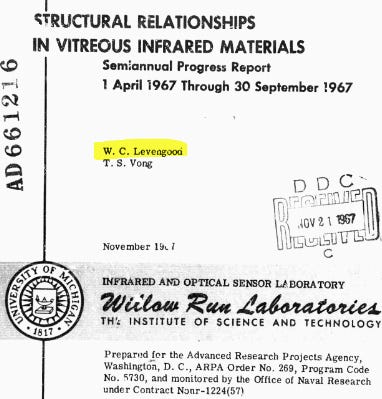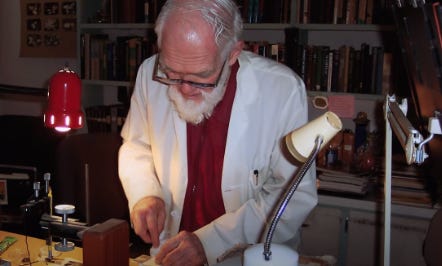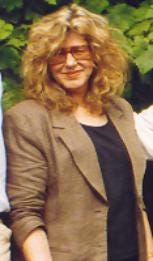This is the first part of a longer story about legacy, a scientist and crop circles
In the spring of 1995, University of Michigan biophysicist William C. “Lefty” Levengood found himself examining the lawn of a middle-aged woman claiming to be an alien abductee.
Levengood was particularly interested in the ring-shaped portions of grass that appeared greener and faster-growing than the plants surrounding them. His analysis ruled out the possibility that the yard-anomaly was a ‘fairy ring’ — a fanciful name given to a natural process that causes fungi to emerge in a circular pattern. When asked about his observations, Levengood told the local Ann Arbor News that he had discovered “alterations in the biochemistry of the plants.” He believed that the formation was caused by “extremely strange energies… that do not fit the paradigms of science.”
Four years earlier, in 1991, Levengood’s private Pinelandia Biophysical Laboratory in Grass Lake, Michigan was inundated with plant and soil samples from crop circles. The small rural community of Grass Lake is located just off Interstate-94 — a major roadway that runs east and west across the lower half of the state. It’s an unlikely destination to send boxes of plants from around the globe. Unsurprisingly, more than one of his packages were delayed due to apprehensive customs agents. Despite the offbeat location, by the mid-1990s Lefty would establish his lab as the scientific epicenter of the worldwide crop circle phenomenon, handling thousands of specimens from hundreds of formations. He would go on to provide scientific analysis for other paranormal subjects ranging from cattle mutilations to supposed alien abductions.
He didn’t always focus on such fringe topics. Early in his career, Levengood authored or contributed to over 50 scientific research papers, with many seeing print in well-known, peer-reviewed journals like Science and Nature. He covered everything from “The Sexual Responses of Male Moths” to “Moisture Condensation Patterns on Glass and Crystalline Surfaces”. Lefty was intensely interested in the natural world, instinctively gravitating toward topics that prepared him to take on the crop circle mystery in his later years. Driven and resolute, Levengood could be single-minded when presented with a challenge — but his determination was also productive. He held two patents for glass preparation techniques before graduating from college (he would go on to register four more patents for inventions from assorted disciplines), earned multiple master’s degrees in various fields of study and enjoyed a successful career in the private agriculture industry.
That was one version of W.C. Levengood — a version that would cease to exist after the accomplished biophysicist became obsessed with the captivating designs appearing in fields around the world. The mystery plagued him so deeply that by the beginning of 1991 he changed the course of his career, eschewing mainstream research to pave the way for an unlikely legacy. After pursuing the elusive phenomenon for decades, Lefty would advance our understanding of energy’s effect on plants and emerge as one of the few scientists willing to risk their reputation by entering the dizzying world of crop circles.
Levengood was born in 1925 in Jackson, Michigan, just 15 miles west of where he later made his home and laboratory. Situated on Interstate-94, the city is large by southern Michigan standards and is best known for hosting the oldest maximum security prison in the state.
He met and married his wife, Glenna, before the age of 20. The two shared a love of the outdoors; neighbors referred to them as “the two nature nuts.” This passion for the natural world planted a seed with Lefty that would later grow to influence his pioneering work in crop circle research.
Sometime before 1953, Levengood relocated to Ohio to attend school at the University of Toledo — setting his sights on a bachelor’s degree in science. He also tried his hand at writing research papers while working for Libbey-Owens-Ford Glass Company, a maker of sheet glass for the construction and automotive industry. One of his first topics was a rousing submission about the nature of crystalline structures (like glass). Lefty had a knack for communicating on paper, even if he wasn’t a refined public speaker. Like all of his pursuits, he poured himself into his work, getting hands-on experience with production and engineering at the glass company. During this stint, he patented an improved method of grinding glass to reduce breakage as well as a process to enhance its composition.
After graduation, Levengood enrolled at Ball State University in Muncie, Indiana to seek his master’s degree. The school was named after the Ball brothers, who had been major donors, landowners and philanthropists in the community. When Lefty attended the college, they were also one of the largest businesses in the area, known for their recognizable glass mason jars adorned with their last name. This convenient association provided Lefty the opportunity to continue his research into the properties of glass while he worked diligently towards his master’s in bioscience.
During his tenure with the Ball Brothers Research Corporation, Levengood submitted a paper to the highly-esteemed journal, Nature. His article was titled Instability Effects in Vortex Rings produced with Liquids (1958), and this early work is noteworthy for its obvious influence on Lefty’s later theories regarding plasma vortices as the driving mechanism behind crop circles. In his article, Levengood describes the behavior of a liquid/clay solution when it’s dropped into a beaker of water. As the droplet makes contact, a swirling whirlpool forms (a “vortex”), creating a ring that expands and distorts as it sinks. He observed how the initial ring spiraled into an assortment of smaller, less organized circular formations as time elapsed.
The images of vortex patterns taken by Levengood look passingly similar to early crop formations depicting simple circles and swirls imprinted in fields. Though it was published decades before the crop circle phenomenon kicked-off, the experiment’s results would go on to shape Levengood’s views on how they were formed.
Lefty graduated from Ball State in 1961 and found his way back to Michigan. He and Glenna chose to settle down in his wife’s hometown of Grass Lake. They purchased a 15-acre plot nestled in the woods across from a lake, surrounding themselves with the natural world they both enjoyed. The husband and wife conservationists continued to acquire adjoining pieces of land with the intention of converting them into a community nature preserve. They eventually amassed over 200 acres and sold them to the Michigan Nature Association for a paltry sum. Shortly thereafter, the entire parcel was dedicated as “Lefglen” (a mash-up of their first names: Lefty and Glenna) and was opened for free to the public.
Dr. Levengood, I presume?
Despite having two degrees, Levengood wasn’t done gathering credentials. In the early 1960s he set out to obtain a PhD from the prestigious University of Michigan — a pursuit that took him 30 miles east of Grass Lake on familiar Interstate-94 to the city of Ann Arbor. The outcome of this pursuit would ultimately become a point of contention when assessing his reputation and perceived credibility.
He started his professional career at U of M as an associate researcher with the Institute of Science and Technology. He continued to publish scientific papers on a variety of subjects, including one on the composition of infrared glass for the federal Advanced Research Projects Agency (ARPA). Along the way, his concentration shifted its focus and he began exploring topics related to biology and environmental systems — material in line with the doctorate he was pursuing.
In 1970, after passing all mandatory coursework and finishing his dissertation regarding bioelectricity in plants, Levengood was on the cusp of securing a doctoral degree. All that remained was the formal defense of his thesis — an act which obliged him to thoroughly discuss his final paper in front of a group of professors. This is where the story gets murky.
According to Lefty’s longtime lab assistant, Penny Kelley, a member of the PhD review committee had a personal vendetta against Levengood and peppered him with a hostile line of questioning. As Penny tells it, Levengood froze under the pressure and was unable to get a word out. He never finished the oral portion of his PhD requirement, failing to earn the “Dr.” title. He settled for a master’s degree in biophysics instead. Confident of his thesis nonetheless, a few years later he went on to publish his final paper in the Journal of Exploratory Biology (1973).
Levengood parted ways with academic circles soon after his unsuccessful run at PhD. He earned a living in the private sector as a research director for various companies and continued to publish papers on biological concepts — writing about the sensitivity of nocturnal moths for Nature and the subtle electric currents present in plants for the Canadian Journal of Botany, among other topics. He also found time to obtain a patent for an “Automatic Seed Analyzer,” which could determine the health of a seed prior to planting. The device worked by running an electric current through the seed and measuring the output to define its viability. His invention provided growers a way to maximize their yield by identifying the hardiest seeds to use.
In 1987 he hung up a shingle on his own private lab, operating Pinelandia Biophysical Laboratory out of a separate building tucked behind his home in Grass Lake. Acting as a scientific advisor to farmers and seed companies, he had the advantage of unrestricted access to a sophisticated lab for testing and analysis. This autonomy also allowed him room to pursue nonconformist areas of science whenever an unorthodox topic aroused his interest.
Croppies, Circlemakers and Cerealogists
While Levengood was busy establishing himself stateside as an agricultural consultant and researcher-for-hire, halfway around the world something strange was happening to the crops in the United Kingdom — and it was escalating. Pictures and newspaper articles coming out of England first told the story of farmers awakening to find circular depressions in their fields. Plants had been flattened with precision to create simple patterns spanning hundreds of feet in diameter. These formations increased in frequency and complexity over the course of the 1980s, and soon hundreds were reported each growing season.
The existence of ‘real’ crop formations, meaning those “produced by external energy forces independent of human influence,” remains hotly contested and largely dismissed. The mainstream narrative holds that the circles first emerged in 1978 when two British humans decided to stomp around in a field of wheat to create their rendition of a ‘flying saucer nest.’ Accepting this admission as fact, most people viewed the imprints in the fields as nothing more than man-made land-art — calling cards stamped into the iconic patchwork of grain that blankets the English countryside.
Not everyone is willing to concede this version of history. Many researchers establish an earlier record of the phenomenon, identifying a plethora of pre-1978 reports that detail unexplained plant disturbances and field depressions. These occurrences are of particular importance to ‘croppies’ (crop circle enthusiasts) because they provide evidence of mysterious crop patterns as an enduring and persistent enigma. These ‘old crop circles’ are often cited as proof of a legitimate phenomenon. Indeed, documented examples of strange imprints appearing in fields go back to the 1600s and would seem to undermine skeptics’ claims that all circles are the result of human activity.
Levengood became interested in the puzzling UK field formations after reading a popular book on the topic by two British cerealogists (crop circle researchers) — Pat Delgado and Colin Andrews. Both men had been on the crop circle scene since its early days in the 1980s, just as the instances began to accelerate in southern England. Convinced that the complex designs were caused by an intelligent force, and not by any natural phenomenon, their work culminated with the release of Circular Evidence (1989). In their book, the two ‘experts’ subtly imply that the circles might somehow be connected with UFOs, but fall short of stating so explicitly. Andrews coyly summarized their position in a 1987 article for the Flying Saucer Review: “The extensive data now gathered … indicates some form of intelligence is involved, probably working in tandem with the magnetic field around our planet and could be an aerial entity of some kind.”
Delgado and Andrews’ supernatural hypothesis stood in stark contrast to a rival theory being formulated in tandem by crop circle researcher and meteorologist, Dr. Terence Meaden (actual PhD). Dr. Meaden visited many of the early UK formations to perform hands-on analysis in 1980, prior to Andrews or Delgado’s arrival on the scene. Drawing upon his experience studying low temperature physics and tornado climatology, Meaden looked to the weather for clues. He developed a natural explanation for the curiously flattened plants, attributing them to “atmospheric plasma vortices” or whirlwinds of electrically charged air. His collective evidence was presented in a book published the same year as Andrews and Delgado’s, titled The Circles Effect and Its Mysteries (1989).
It was during the 1990 peak of circle-frenzy that W.C. Levengood thumbed through a copy of Circular Evidence, becoming enthralled with the pictures of elaborate designs pressed in the grain. His curiosity was further provoked after watching an episode of Unsolved Mysteries that covered the high strangeness happening to crops in the UK. The program was a catalyst for Lefty. It revealed that very little ‘serious’ scientific study had been carried out on the plants inside of crop circles. Being well-versed in biology, vortex formations and energy transference in living systems, the biophysicist was presented with the perfect problem to solve. He now needed to get his hands on samples of the affected crops lying bent in fields 6,000 miles away.
1990 was also a pivotal year for a woman named Nancy Talbott. A former music festival producer and one-time Harvard research analyst living in Cambridge, Massachusetts, crop circles wound their way into Nancy’s life as she was casually browsing the bookshelves looking for something to read. She came across a British magazine featuring the latest intricate crop designs and became deeply intrigued by the puzzling images on the cover. It didn’t take long before Talbott became a bona fide croppie and that summer she made her way to England to study the phenomenon firsthand. She was addicted to the seasonal mystery and sought to devote more time and resources to uncovering the truth behind the circles. Her quest would eventually bring her into contact with W.C. Levengood and cement a partnership under the auspices of applying science to the supernatural.
Although their relationship would get off to a promising start, it would soon prove both toxic and unproductive to their original mission.

